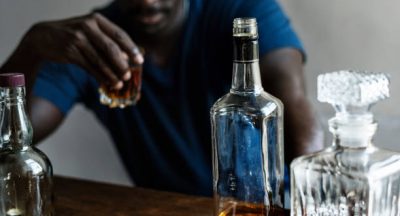
Understanding Alcohol
Alcohol is a legal, controlled substance that lowers anxiety and inhibitions. It also has a broad range of side effects, from loss of coordination to slurred speech. Not everyone who drinks is an alcoholic, but anyone whose life is negatively affected by alcohol on a consistent basis is considered to have an alcohol use disorder. Alcohol is commonly consumed as a drink in various forms, including beer, wine, and hard liquor.
Beer
Beer is an alcoholic drink typically made from water, barley, hops, and yeast. Compared to wine or hard liquor, beer usually has the lowest alcohol content by volume (ABV). Beer’s ABV ranges from about 2 to 12 percent, with the most commonly consumed beers (Budweiser, Coors Light, Miller Lite, Corona, Busch, etc.) falling in the 4 to 6 percent range. For most people it takes 3 to 5 beers to be over the legal driving limit.
Beer has become synonymous with many activities in American culture. Drinking games on college campuses revolve around it, happy hours are the go-to activity for professionals, and good luck finding a sporting event without it.
The rise of craft beer has even made beer consumption fashionable, with microbreweries and home brewers pushing the limits on what new flavors and tastes can be introduced. One unfortunate side effect of the craft beer revolution is that beers may have significantly higher amounts of alcohol than the average domestic draft — some can be as high as 11 or 12 percent.
Even people who drink during social activities or only drink craft beer are susceptible to an alcohol use disorder. This is especially true when “social drinkers” continue to drink when everyone else has stopped or feel the need to drink during uncomfortable or boring situations. Contact a treatment provider today to discuss available treatments for beer addiction.
Wine
Wine is made from fermented grapes or other fruits, such as pomegranates or berries. It is most commonly sold as white or red with a variety of flavor profiles. Chardonnay, pinot grigio, riesling, and moscato are examples of white wines while merlot, cabernet, pinot noir, and zinfandel are reds. Varieties are based on grape type.
Compared to beer, wine has a more concentrated amount of alcohol. An average pour of wine (5 oz.) is equivalent in alcohol content to 12 oz. of beer. Wine is often consumed at dinner parties or alongside gourmet cheese and cracker pairings. Its status as a “classy” drink can make it harder to spot when someone has a problem.
Women make up 59 percent of wine drinkers in the United States and are often the targeted audience in advertising campaigns promoting the drink. Women have less body mass and less water content than men in their bodies. Body water diffuses the alcohol content from wine consumption. This means that women have a higher concentration of alcohol in their blood stream when they drink than men. This causes women to become impaired more quickly when drinking wine and also exposes their brains and other organs to more alcohol before it’s broken down.
Because of this, women may be disproportionately susceptible to a use disorder. However, either gender can develop a problem with wine. If you or someone you care about has been drinking wine more frequently than intended or using it to combat anxious or depressive feelings, there may be a deeper issue at play. Contact a treatment provider today to discuss available treatments for wine addiction.
Liquor
Liquor is the umbrella term for hard alcoholic drinks or spirits like tequila, vodka, gin, rum, and whiskey. Liquor has a much higher ABV than beer or wine and is often mixed with sodas, juices, or water. The average size of a liquor pour is 1.5 oz. When not mixed into drinks, liquor is consumed as a shot or “neat.” Carbonation speeds up the absorption of alcohol into the bloodstream, so drinking liquor mixed with soda can cause quicker intoxication. The lower liquid content of shots make them easier to consume, leading to a higher risk of abuse and subsequent drunkenness.
Many longtime drinkers associate different drinks with different feelings of intoxication. Science has yet to prove this, with studies showing that alcohol produces the same effects in everyone regardless of the type of drink being consumed. However, the social setting in which an alcoholic beverage is consumed may impact the drinker’s perception of their own intoxication. Someone having a glass of wine at dinner is more likely to report feeling tired and happy, while tequila shots at a high-energy party can produce a vastly different kind of intoxication.
Those with a severe alcohol use disorder may feel that they can’t start their day without a swig of vodka or finish it without a glass of whiskey on the rocks. Regardless of the type of liquor consumed, alcohol of any kind possesses serious addiction potential. Contact a treatment provider today to discuss available treatments for liquor addiction.
Understanding Binge Drinking
A subset of problem drinkers, binge drinkers are men who consume five or more alcoholic drinks or women who consume four or more over a two-hour period. An infrequent binge drinker may be able to stop on his or her own. Someone addicted to alcohol, however, may want to stop drinking and not be able to without help. In many cases prolonged binge drinking can develop into alcoholism.
Immediate Effects Of Alcohol
Alcohol is a Central Nervous System (CNS) Depressant, so it slows down mental and bodily processes. Users may experience a decrease in feelings of anxiety or stress after having a drink. Alcohol is commonly touted as a social lubricant, meaning drinkers are more likely to feel confidence in meeting new people and be less concerned with how they are perceived by others.
Because alcohol is legal and widely accepted in society, it can be hard to tell the difference between casual use and abuse. In general, any use of alcohol that results in negative consequences is considered abuse. Some of the negative consequences of alcohol use include:
- Physical harm or illness
- Strained relationships
- Problems at work
- Financial difficulty
When abuse becomes more frequent it can escalate into an addiction.
Addiction To Alcohol
Alcohol addiction, also known as alcoholism, is marked by a craving for alcohol and the inability to stop drinking — even when it causes extreme personal or social harm. Signs of an alcohol addiction include frequently drinking more than intended, wanting to stop drinking but being unable to, developing a tolerance to alcohol, feeling symptoms of withdrawal when stopping, letting personal and professional responsibilities flounder in favor of drinking, and spending an extreme amount of time trying to get and drink alcohol.
High-Functioning Alcoholics
There is a specific class of alcoholism known as high-functioning alcoholism. People who are high-functioning alcoholics are capable of keeping their alcoholism from interfering in their professional and personal lives.
A New York Times article estimated that as many as half of all alcoholics are high-functioning alcoholics. Lawyers, professors, and doctors make up a large portion of these individuals.
High-functioning alcoholics rarely recognize they have a problem until they face severe alcohol-related consequences. The danger of high-functioning alcoholism is that it can continue for years without a person ever recognizing they have a problem.
Alcohol And Other Drugs
Because it is so common in today’s culture, alcohol is often abused alongside other drugs. As a CNS depressant alcohol poses a serious risk when mixed with other drugs of the same class, such as benzodiazepines and some painkillers. Alcohol on its own can be dangerous, but combining it with other substances can quickly prove lethal.
Related Posts
Understanding Alcohol
Alcohol is a legal, controlled substance that lowers anxiety and inhibitions. It...
Anger Management
Anger is a powerful emotion that can be defined as a strong feeling of annoyance,...



